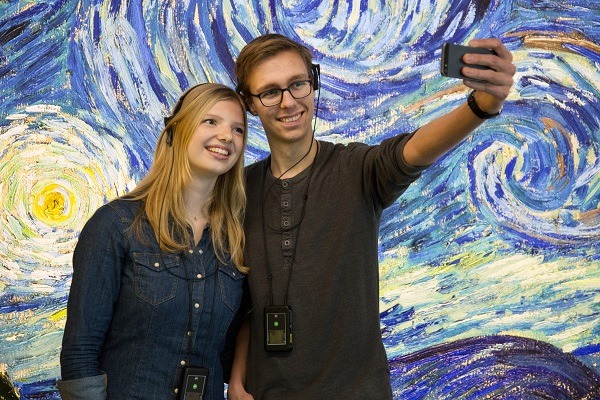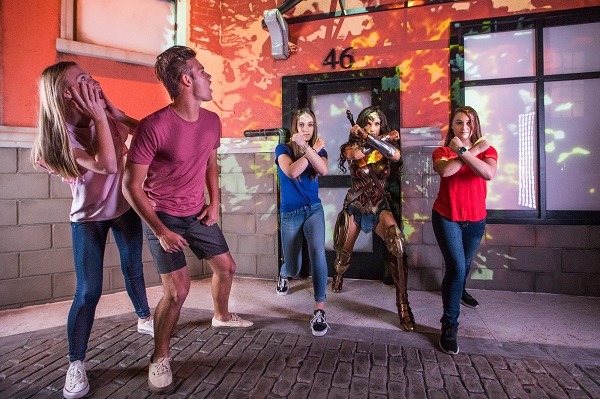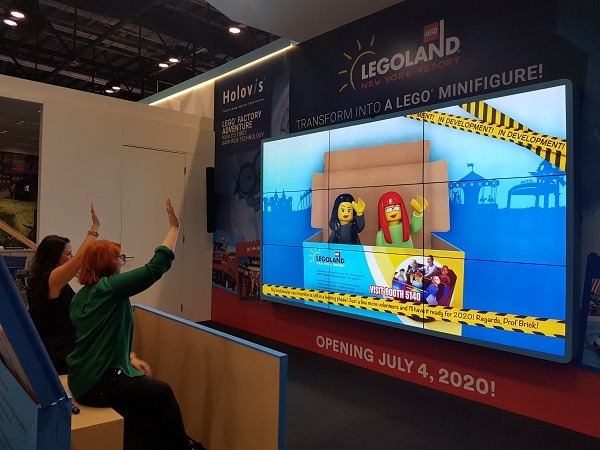Strap yourself in, we’re going for a ride
Theme parks, family entertainment centres and museums have started dipping their toe in the AV world. Sean Carroll looks into what’s happening and what’s next for this side of the industry.
Theme parks, family entertainment centres (FECs) and museums are great fun, there’s no disputing that. They’re sources of entertainment and information that we visit in our leisure time.
Because of this, they compete with other forms of entertainment such as sporting events, concerts, plays, films, TV or gaming. Why should someone go visit a museum if they can just watch a Netflix documentary from home on the same topic?
That might be a rather morbid and slightly sad sentence to read, but there is truth in it. Just like the digital world, these spaces are competing for our eyeballs, our clicks and our attention. Some of these parts of the industry haven’t changed in 50, or even 100-plus years in the case of museums.
ADVERTISEMENT
But as Bob Dylan said, the times they are a-changin’ and in order to revolutionise, people are turning to AV to create an immersive and unique experience.
“First and foremost, technology is a means to an end,” Barco segment marketing manager for ProAV Leander Werbrouck says.
“Storytelling comes first and technology comes second. The best recipe for success is to have a great story and co-create with the right partners to make magic happen.
“An immersive experience should impress end users while maintaining the uniqueness of the museum, FEC or theme park it was built for.”
Barco Australia and New Zealand managing director Claudio Cardile mentions that engagement is the key outcome. It attracts business and most importantly: repeat business with growth in word of mouth or a social media presence.
The Vincent van Gogh Museum in Amsterdam has expanded upon its offering with the Meet Vincent van Gogh Experience: a touring, award-winning, multi-sensory exhibition that brings people closer to the artist through his artwork, letters and AV.
“Vincent was writing letters almost every day to his family and friends. Most of the letters are in the museum collection,” Meet Vincent van Gogh Experience general manager Arnold van de Water says.
“When you’re stepping inside the exhibition or the experience so to speak, you follow the same life journey as Vincent made 130 years ago.”
The museum uses RSF Optima audio devices that are ‘set and forget’. They communicate with IR and HF beacons throughout the exhibition. Combining them time codes from the show controller and video to them triggers various dialogue and sound effects.
“For example, when walking between places you hear about wheat fields in southern parts of France and at the same time, the show controls starts a fan that blow wind through your hair,” Arnold explains.
The experience features goes beyond video projections only by combining sound, light, special effects to recreate the world may have looked like in Vincent’s time and, of course, digital renditions of his artwork.
Storytelling is also at the forefront of the AV installation in the Royal Liver Building in Liverpool, England. Holovis, a UK-based creator of immersive AV experiences, was responsible for transforming the iconic building on the Liverpool waterfront.
The building features a clock tower and viewing platform, both larger than Big Ben, that Holovis used as canvases for an indoor projection mapping show. It surrounds guests with a 270° projection and 5:1 surround sound solution that immerses visitors in the city’s history and the story of the two mythical Liver Bird sculptures.
On top of this, visitors can download an app designed and created by Holovis that lets them interact with various moments throughout the experience. This pulls the visitor in and makes them more than just an onlooker, creating an individualised experience.
“The discoveries that guests make allows them to customise their visit, by unlocking more secrets that are akin to their interests,” Holovis creative director Peter Cliff explains.
“As they progress on the experience, the moments from the app perfectly compliment the narrative of their guide, which is as entertaining as it is educational.
“We have added a layer of adventure and gamification to the experience, which encourages visitors to further engage. It has also given the attraction an exciting digital platform, without the need for expensive and sometimes impractical screens, especially when working in a Grade 1 listed building (a building of exceptional interest per Historic England).
“The app is a great addition to the experience that is helping guests get more immersed into the history of the building and the wider story of the glorious city of Liverpool.”
Holovis has also worked with Madame Tussauds in Orlando and Sydney to extend the Justice League: A Call for Heroes experience with projection mapping, enhanced audio/sound effects and interactive elements.
As guests walk alongside the wax figures, they can take part in activities like running alongside The Flash, strike Wonder Woman’s iconic pose or help Superman lift a car.
What’s unique about this experience is that visitors have to interact with the exhibit to unlock its full potential.
“We’ve made the experience as natural as possible to interact with the superheroes,” Peter says.
“All of the tasks are motion-based and things that guests are naturally compelled to do like strike the Wonder Woman pose or grab Aquaman’s trident.”
One of the coolest aspects is the life-sized bat signal that guests must shine on a figure through billowing smoke which then triggers an event and, again, pulls the guest further into the experience.
An issue that arises from interactive experiences is making sure the end user can’t see anything that goes on behind the scenes. This is paramount with all AV experiences but the more you can pull the user in and create an illusion that they’re involved, the better.
“We also place a high importance on keeping technology invisible from the guest so as not to dispel the magical illusions,” Peter outlines.
“One loose connection in an experience can ruin everything.”
Arnold echoes this sentiment and has designed the Van Gogh Experience so there is as little front-facing technology as possible.
“All of our cables for AV, so Dali, DMX or even just plain speaker, internet or power cables are completely hidden. Everything runs through our cable trays that are built into the walling system,” he says.
“We’ve added the kinds of refinements that are used in a permanent installation and applied it to the touring kit.”
When speaking about the touring kit, Arnold mentions the flexibility of the entire system and how important it is to make sure it’s easy to use for someone operating it for the first time.
“We reduce pre-production so we don’t need to reinvent the wheel each time we go to a new city. We hand the entire system over to the local promoter and it’s in their hands,” he says.
“What we did is made a key that you put in the set at the entrance that is literally turnkey. The venue manager or whoever is in control of the experience puts the key in, turns it on and that turns on the whole system. There’s no need for complex procedures or multiple start-up operations.
“They can just say: ‘okay, it’s show time’. If you want to create design principles, you need to reduce it to this level of simplicity to make it all work.”
Another way Arnold and his team have made things easier is by prioritising an special self supporting wall system that includes backlit lighting.
“When we go to a new venue, we don’t know what the lighting is like, if there’s a grid, can we rig it, can we drill in the ceiling and so on. We try and envision a fully self-supporting system.”
What’s most exciting about this side of the industry is that it’s still very much in its infancy. While AV is used in other experiences like concerts or theatres, making the most of AV technology in large scale touring exhibitions and theme parks is a relatively new venture.
“Touring exhibitions and FECs are the fastest-growing part of the industry for suppliers, for technology and for AV companies,” Arnold says.
“For instance, you don’t need to present a museum exhibition these days inside a museum. You can do it in non-traditional places right?”
Manufacturers like Barco are constantly innovating with projection technology which enables this side of the industry to innovate. They also have an extensive repertoire of projecting onto non-traditional surfaces including the Sydney Opera House, the Arc de Triomphe in Paris and various Hindi religious deities among others.
“An example of our technology is our F80s single-chip DLP laser projector, as well as our recently introduced three-chip DLP laser projector UDM. The latter is the world’s smallest 22k lumen projector of its kind,” Leander mentions.
“We have also introduced Barco Insights, a secure cloud-based platform for monitoring and diagnostics of projectors supported by built-in device connectivity. This guarantees maximum operational efficiency, increased customer satisfaction and loyalty, and boosts service offerings for many partners who are using our products.”
Holovis has begun working with multivariate experiences. Guests can take the same pathway in one of these entertainment centres but have different experiences from the people next to them.
“Working alongside Merlin Entertainments, we have created the ultimate on-ride guest personalisation with the LEGO Factory Adventure ride in LEGOLAND New York,” Peter says.
Tracking technology on the ride identifies attributes of guests and maps their position in the virtual space and transforms them into LEGO Minifigures right in front of them.
This tracking technology from Holovis, dubbed HoloTrac, can even help with park-wide interactions.
“For example, using our recognition module, guests can set out on quests to learn spells that they then perform to fire water cannons, open secret doors or turn lights on inside themed spaces. When combined with the attribute recognition module, if someone else tries to copy the gesture but hasn’t been inducted, the magic won’t work. This is removing barriers to entry, such as needing to purchase expensive RFID enabled gadgets, and puts the guest in control of their experience.”
User experiences are developing and guests are lapping it up.
Instead of just scaling up, making bigger screens and louder speakers, these entertainment centres have the unique opportunity of leading the charge of innovation, venturing out into the wide world of AV and finding the next big thing.
Is the next big thing HoloTrac and the interactivity of Holovis’ solutions? Displaying and projecting onto non-traditional surfaces like the Sydney Opera House? Or has it not been invented yet?
That’s what is most exciting about this segment of the industry: we may all read this article in five years, maybe less, and think it has aged. We don’t know how fast or how far AV can take us but I’m excited to strap in and go for a ride to find out.
-
ADVERTISEMENT
-
ADVERTISEMENT
-
ADVERTISEMENT
-
ADVERTISEMENT



